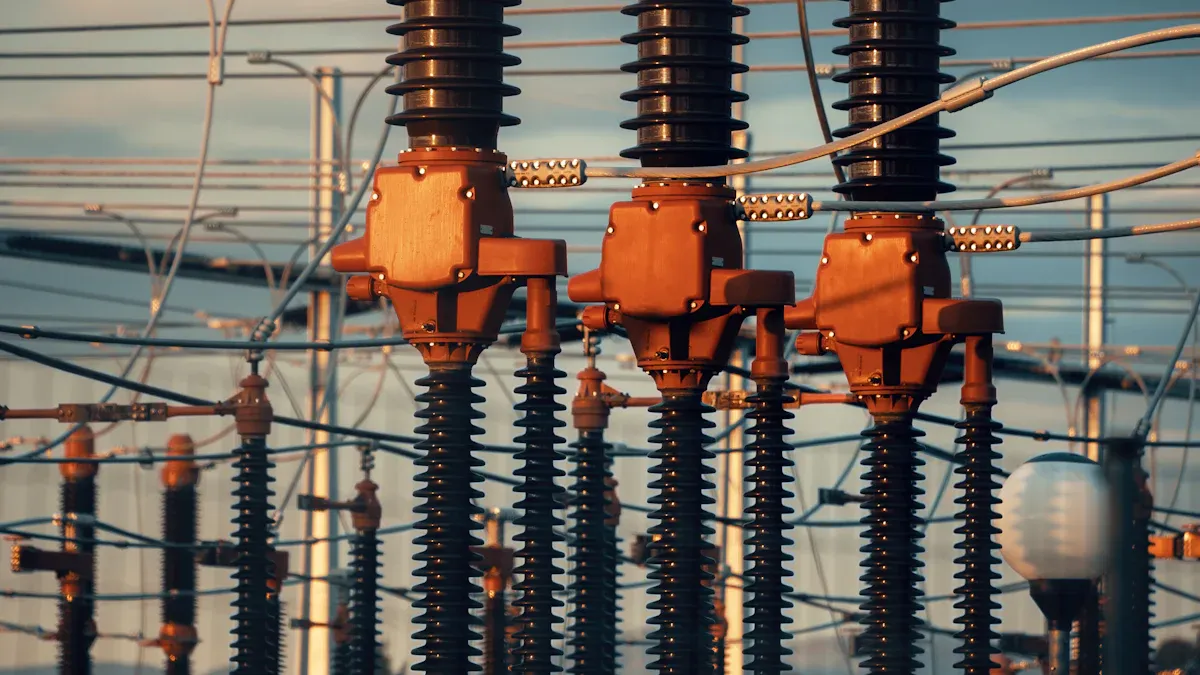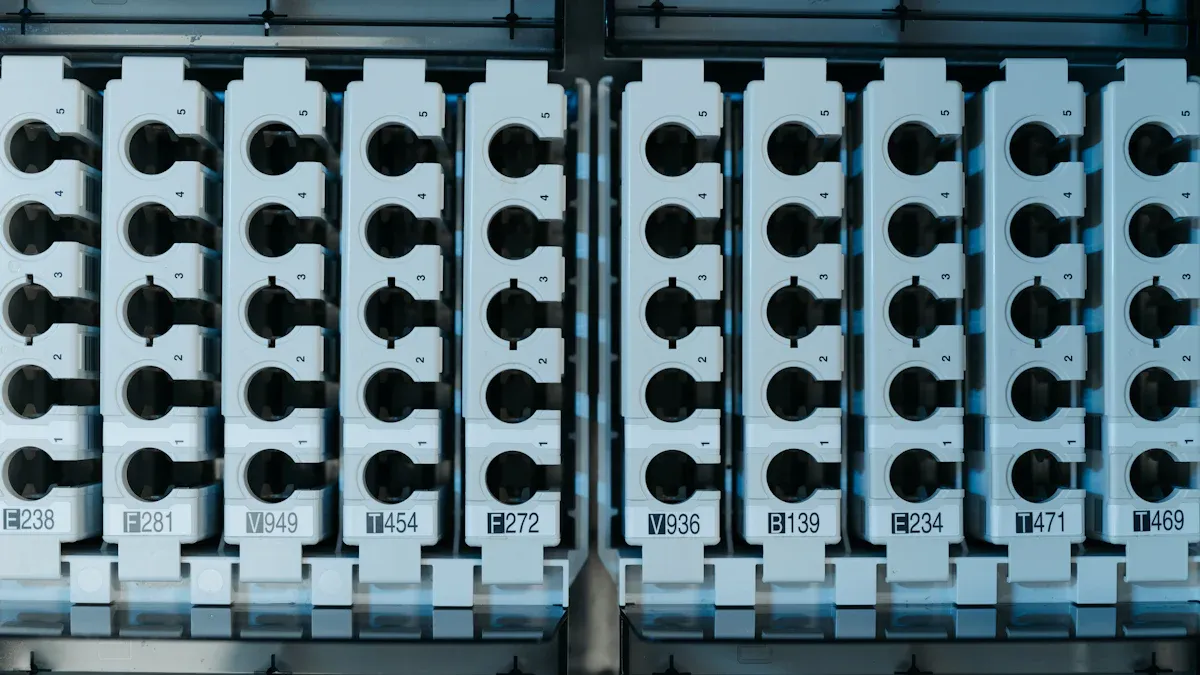Power Distribution Units (PDUs) play a critical role in managing electrical power in data centers and server rooms. The primary difference between a basic PDU and a metered PDU lies in their functionality. A basic PDU distributes power without monitoring features, while a metered PDU provides real-time data on power usage. Understanding these distinctions ensures users select the appropriate solution for their operational needs. Making informed decisions improves energy efficiency and optimizes equipment performance.
Key Takeaways
- Basic PDUs are affordable tools that share power but lack monitoring.
- Metered PDUs show live power use, helping save energy and money.
- Picking a PDU means thinking about power needs and future growth.
- Basic PDUs work well for small spaces, while metered ones fit big setups like data centers.
- Metered PDUs give better info and keep devices safe from too much power.
What is a Basic PDU?

A Basic PDU, or Power Distribution Unit, is a fundamental device designed to distribute electrical power to multiple connected devices. It serves as a reliable and cost-effective solution for powering equipment in data centers, server rooms, and other IT environments. Unlike advanced PDUs, it lacks monitoring or remote management capabilities, focusing solely on power distribution.
Key Features of a Basic PDU
Basic PDUs are defined by their straightforward design and essential technical specifications. These include:
| Specification Type | Details |
|---|---|
| Input Power Capacity | Up to 67kVA; Higher capacity available in ETO models. |
| Input Currents | From 12A up to 100A per line. |
| Input Voltages | Single-phase: 100V, 120V, 200V, 208V, 230V, 240V, 277V; Three-phase: 208V, 400V, 415V, 480V. |
| Certifications | UL, cULs, Canada ICES-003, FCC Part 15 Class A, RoHS, CE, SAA, PSE, UKCA, KC, ISO certifications. |
These features ensure compatibility with a wide range of electrical systems and compliance with international safety standards.
Benefits of Using a Basic PDU
Basic PDUs offer several advantages for organizations seeking a simple power distribution solution:
- Cost-Effectiveness: They provide an affordable option for environments that do not require advanced monitoring.
- Ease of Use: Their plug-and-play design simplifies installation and operation.
- Reliability: Built with durable components, they ensure consistent power delivery to connected devices.
- Scalability: Available in various configurations, they can support small setups or large-scale deployments.
These benefits make Basic PDUs a practical choice for businesses prioritizing simplicity and reliability.
Common Use Cases for Basic PDUs
Basic PDUs are commonly used in environments where power distribution is the primary requirement. Typical applications include:
- Small Server Rooms: Ideal for powering servers, switches, and other IT equipment.
- Edge Computing Sites: Suitable for remote locations with minimal infrastructure.
- Retail and Office Spaces: Used to power point-of-sale systems, workstations, and other devices.
Their versatility and straightforward functionality make them a popular choice across various industries.
What is a Metered PDU?

A Metered Power Distribution Unit (PDU) is an advanced device designed to distribute power while providing real-time monitoring of electrical metrics. Unlike a Basic PDU, it offers detailed insights into power usage, enabling users to track consumption and optimize energy efficiency. This makes it an essential tool for environments where power management and monitoring are critical.
Key Features of a Metered PDU
Metered PDUs come equipped with features that enhance their functionality and usability. These include:
| Feature | Description |
|---|---|
| Power Tracking | Tracks power consumption data via a local display. |
| Metrics Display | Provides metrics such as current, voltage, and power factor. |
| Monitoring Level | Allows monitoring at the outlet level for detailed insights. |
These features enable users to monitor power usage effectively, ensuring better control over energy consumption and operational costs.
Benefits of Using a Metered PDU
Metered PDUs offer several advantages that make them a valuable addition to modern IT environments:
- Enhanced Energy Management: Real-time monitoring helps identify inefficiencies and reduce energy waste.
- Improved Equipment Protection: Monitoring metrics like voltage and current ensures devices operate within safe limits.
- Operational Insights: Detailed data allows for better planning and resource allocation.
- Compliance Support: Helps meet energy efficiency standards and regulatory requirements.
These benefits make Metered PDUs indispensable for organizations aiming to optimize power usage and maintain operational efficiency.
Common Use Cases for Metered PDUs
Metered PDUs are widely used in environments where power monitoring is essential. Typical applications include:
- Data Centers: Ideal for tracking power usage across servers and networking equipment.
- Server Rooms: Ensures efficient power distribution and monitoring for critical IT infrastructure.
- Industrial Facilities: Supports energy management in manufacturing and production environments.
Their ability to provide actionable insights makes them a preferred choice for businesses prioritizing energy efficiency and system reliability.
Comparing Basic and Metered PDUs
Functional Differences
Basic and Metered PDUs differ significantly in their functionality. A Basic PDU focuses solely on power distribution, making it a straightforward and cost-effective solution. It lacks advanced features such as monitoring or control capabilities. In contrast, Metered PDUs provide additional functionalities, including real-time power monitoring and outlet-level control. These features allow users to track energy consumption and manage power distribution more effectively.
| Feature | Basic PDUs | Metered PDUs |
|---|---|---|
| Cost | Low-cost entry-level solution | Higher cost due to advanced features |
| Monitoring | No real-time monitoring | Real-time monitoring with built-in meters |
| Control | Limited control, no remote management | Outlet-level control and monitoring available |
| Use Cases | Small to medium data centers, budget-conscious | Larger data centers needing detailed monitoring |
| Overload Prevention | No alerts for overloads | Alerts for approaching circuit limits |
Metered PDUs are ideal for environments requiring detailed power management, while Basic PDUs suit simpler setups where monitoring is unnecessary.
Monitoring and Reporting Capabilities
The ability to monitor and report power usage is a defining feature of Metered PDUs. These devices provide real-time data on metrics such as voltage, current, and power factor. They also include user-defined alarms that warn about potential overloads, ensuring the safety of connected equipment. Basic PDUs, on the other hand, do not offer any monitoring or reporting capabilities.
| Feature/Aspect | Metered PDUs | Basic Models |
|---|---|---|
| Real-time Monitoring | Yes, shows live power usage | No |
| User-defined Alarms | Yes, warns about overload risks | No |
| Local Display | Yes, shows info for the whole PDU | No |
| Cost | Higher due to smart features | Lower, more budget-friendly |
Metered PDUs also support advanced functionalities like outlet-level monitoring and remote management. These features enable users to optimize energy consumption and ensure compliance with energy efficiency standards. Basic PDUs, being simpler devices, are limited to distributing power without providing any insights into usage.
Tip: For organizations aiming to improve energy efficiency and reduce operational costs, Metered PDUs offer a significant advantage over Basic PDUs.
Applications in Different Environments
The choice between Basic and Metered PDUs depends largely on the specific requirements of the environment. Basic PDUs are suitable for small-scale setups where power distribution is the primary concern. They are often used in small server rooms, edge computing sites, and retail spaces. Their simplicity and affordability make them an excellent choice for budget-conscious organizations.
Metered PDUs, however, are designed for more complex environments. They are commonly deployed in data centers, server rooms, and industrial facilities where power monitoring and management are critical. These devices support capacity planning, maximize uptime, and enhance productivity through features like remote management and environmental monitoring.
- Basic PDUs: Simple power distribution devices, akin to large power strips, lacking advanced monitoring features.
- Metered PDUs: Offer advanced features such as outlet-level metering, power control, and environmental monitoring, enabling better management of power loads and conditions in data centers.
Metered PDUs are particularly valuable for organizations looking to reduce energy consumption and improve operational efficiency. Their ability to provide actionable insights makes them indispensable in modern IT environments.
How to Choose the Right PDU
Factors to Consider When Selecting a PDU
Choosing the right Power Distribution Unit (PDU) requires careful evaluation of several factors to ensure compatibility, efficiency, and scalability. Organizations must assess their specific needs and operational goals before making a decision. Below are key considerations to guide the selection process:
| Consideration Type | Details |
|---|---|
| Assessing Power Needs | Evaluate total load, phase balance, and growth projections to determine power requirements. |
| Environmental Considerations | Assess temperature and humidity levels, and choose PDUs suitable for specific environmental conditions. |
| Scalability and Flexibility | Opt for modular PDUs that allow for future expansion and reconfiguration without major overhauls. |
Understanding power requirements is critical. Schneider Electric’s research highlights that maximum power combinations for rack PDUs at 400V range from 33kW to 35kW per rack. This insight helps data center managers select PDUs that align with their power distribution needs. Additionally, environmental conditions such as temperature and humidity must be considered to ensure the PDU operates reliably in its intended environment.
For organizations planning future growth, scalability is a vital factor. Modular PDUs provide flexibility, allowing businesses to expand or reconfigure their power distribution systems without significant disruptions. This adaptability ensures long-term value and operational efficiency.
Understanding the differences between basic and metered PDUs helps organizations make informed decisions. Basic PDUs focus on simple power distribution, while metered PDUs offer monitoring capabilities for tracking energy consumption.
| Feature | Basic PDU | Metered PDU |
|---|---|---|
| Monitoring Capability | None | Basic monitoring with built-in meters |
| Data Collection | Manual | Real-time data for tracking energy usage |
| Ideal Use Case | Simple power distribution | Environments needing monitoring |
| Cost-Effectiveness | Lower | Cost-effective for basic monitoring needs |
| Complexity | Simple | More complex due to monitoring features |
To choose the right PDU, users should evaluate their operational needs and growth plans. Metered PDUs suit environments requiring energy tracking and overload prevention. Basic PDUs work well for straightforward setups prioritizing cost-efficiency.
Tip: Select metered PDUs for enhanced reliability and energy management in data centers or server rooms. Opt for basic PDUs in smaller, budget-conscious environments.
FAQ
What is the primary difference between a basic and a metered PDU?
A basic PDU distributes power without monitoring capabilities. A metered PDU, however, provides real-time data on power usage, enabling users to track energy consumption and optimize efficiency. This distinction makes metered PDUs ideal for environments requiring detailed power management.
Can a basic PDU be upgraded to include monitoring features?
No, basic PDUs lack the hardware and software required for monitoring. Users needing monitoring capabilities should consider purchasing a metered or smart PDU. These devices are specifically designed to provide real-time insights into power usage and operational metrics.
Are metered PDUs suitable for small server rooms?
Yes, metered PDUs can benefit small server rooms by providing insights into power usage and preventing overloads. However, for setups with minimal monitoring needs, a basic PDU may suffice as a cost-effective alternative.
How do I determine the right PDU for my setup?
Evaluate your power distribution needs, monitoring requirements, and budget. Basic PDUs suit simple setups prioritizing cost-efficiency. Metered PDUs are better for environments requiring energy tracking and operational insights. Consider scalability if future expansion is anticipated.
Do metered PDUs support remote management?
No, metered PDUs typically provide local monitoring through a display. For remote management, users should consider smart PDUs, which offer advanced features like remote access, outlet-level control, and environmental monitoring.
Tip: Always assess your operational goals and infrastructure needs before selecting a PDU to ensure compatibility and efficiency.
Post time: May-16-2025





